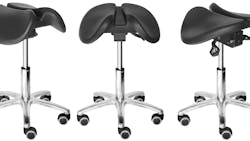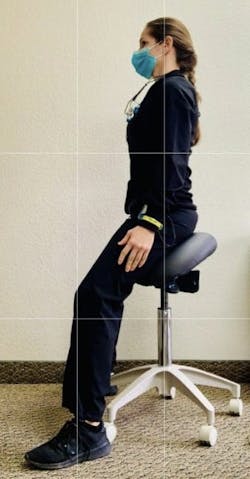The chair we use the most: Does it fit your body?
As dental hygienists, we live in a world of precision and repetition, spending long hours perched on a chair with one foot on a wheel. We are focused, immobile, and-more often than we'd like to admit-uncomfortable. That subtle ache in our lower back or the pins-and-needles sensation in our hips or thighs is not just part of the job. It's the body waving a red flag. If a progression of muscle fatigue, ligament and tendon strain, nerve involvement, and skeletal changes ending in dysfunction sounds familiar, keep reading.1
The problem with flat chairs
Biomechanically, flat chairs don't work. They pull the lumbar spine flat, increasing disc pressure and paving the way for chronic back pain.2 Dental operator chairs are not furniture; they are meant to be individualized tools that reduce fatigue and musculoskeletal injury.
During ergonomic coaching, I've seen more hygienists with their bodies fully contracted, leaning forward with their backs on fire and desperate for a solution. Not surprisingly, 64-91% of us experience body pain.3
Enter the saddle stool
The ergonomics of elevated seating are designed to promote neutral posture by correctly aligning the pelvis and spine, thus reducing strain and fatigue. Studies overwhelmingly show that saddle stools reduce pain.4,5 But not all saddles are created equal, and using one that doesn't fit your unique body, or not sitting on it correctly, can kill the comfort factor or create discomfort. Even with ergonomics education and nearly two decades as a hygienist, my first two saddle experiences we painfully awful. I nearly wrote them off. But after a proper fitting and guidance on adjusting it, I fell in love. Now? I'd rather stand all day than use a flat seat.
Stool features to look out for
Let's break down saddle stool features that actually matter:
Seat pan shape: The shape of the seat pan is foundational. It determines how the pelvis aligns and how comfortably the legs rest.
-
Narrow pans: Ideal for smaller builds. They reduce thigh pressure.
-
Wide pans: Best for taller or broader users or those resistant to elevated seating.
-
Hybrid shapes: Triangular, split seat, or western styles can work for a range of pelvic shapes and sizes.
-
Horn variations: The "horn" (front piece between the legs) should match the pelvic structure-not necessarily one's clothing size. A wide horn might suit wider hips, while a smaller one fits narrower frames better.
Gel cushioning: Sitting shouldn't feel like a punishment. Gel cushioning adapts to your body, distributes weight evenly, and adds longevity to the stool.
Seat pan tilt adjustability: Pan tilt isn't just a bonus-it's a necessity. The ability to adjust the angle of the seat pan allows for optimization of the pelvis. A slight forward tilt often works best for maintaining a neutral spine, but adjustability allows for unique anatomy and posture changes.
Height adjustability: Forget the "thighs parallel to the floor" rule. That doesn't apply here. While keeping the feet flat on the ground, bring the pan up as much as possible. If it's too low, the spine flattens and the shoulders tense and fall forward.
Durability and stability: The intricate work we perform demands steady seating. A five-star wheelbase with smooth gliding wheels is optimal.
Choosing a saddle stool is much like shopping for jeans. Would we ever buy the first pair we try on? Of course not! That "just right" feeling of sitting on a saddle stool is created when the vertebrae and pelvic bones are correctly aligned so that the discs have even pressure from the midback to the tailbone. Here's what to feel for when auditioning a saddle:
-
Assess how the seat pan supports your pelvis and lower back as well as the legs. Do the thighs feel pushed too far apart or supported?
-
Does it relieve pressure points or create discomfort? Some stools offer a gel seat insert for the cushion, which is worth it!
-
Is there a position where the shoulders naturally relax?
-
With both feet lifted, does it feel centered and supported?
Don't rush this decision. Sit for several minutes on several models. Trade shows like RDH Under One Roof are great for this! Be picky. Your body will thank you!
Sit well, work well
By prioritizing ergonomics, testing before purchasing, and focusing on essential features like seat pan shape and adjustability, it's not just buying a chair-it's investing in your health, comfort, and career success. Dental hygiene requires precision, patience, and skill, and the right saddle stool can support you every step of the way. After all, this might be the most important chair you ever buy.
Editor's note: This article appeared in the August/September 2025 print edition of RDH magazine. Dental hygienists in North America are eligible for a complimentary print subscription. Sign up here.
References:
-
Musculoskeletal disorders. University of North Carolina Chapel Hill. Accessed June 1, 2025. https://ehs.unc.edu/topics/ergonomics/musculoskeletal-disorders/
-
Nachemson AL. Disc pressure measurements. Spine (Phila Pa 1976). 1981;6(1):93-7. doi:10.1097/00007632-198101000-00020
-
Saccucci M, Zumbo G, Mercuri P, et al. Musculoskeletal disorders related to dental hygienist profession. Int J Dent Hyg. 2022;20(3):571-579. doi:10.1111/idh.12596
-
Labbafinejad Y, Ghasemi MS, Bagherzadeh A, et al. Saddle seat reduces musculoskeletal discomfort in microsurgery surgeons. Int J Occup Saf Ergon. 2019;25(4):545-550. doi:10.1080/10803548.2017.1389463
-
Lis AM, Black KM, Korn H, et al. Association between sitting and occupational LBP. Eur Spine J. 2007;16(2):283-98. doi:10.1007/s00586-006-0143-7
About the Author

Katrina Klein, RDH, CEAS, CPT
Katrina is an 18-year registered dental hygienist, national speaker, author, competitive bodybuilder, certified personal trainer, certified ergonomic assessment specialist, and biomechanics nerd. She’s the founder of ErgoFitLife, where she teaches that ergonomics and fitness are a lifestyle to prevent, reduce, and even eliminate workplace pain. You can reach Katrina at [email protected].

